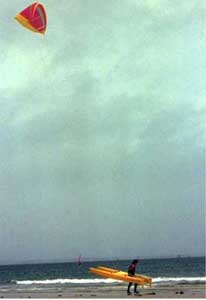The Kiteboarding history
Kitesurf, also called kiteboard, kiteboarding or flysurf depending on which country you’re in, this fantastic new sport which is winning new converts daily, which fires up the watching crowds and which, today, the media can’t seem to get enough of, has been rattling around people’s brains as an idea since the 60s. But it took until 1984 to become anything like reality when Dominique and Bruno Legaignoux, two Frenchies brothers obsessed by sailing and water sports, started working on the principle and applied for the patent for their ‘curved wing with inflatable structure’.
The Vision
Dominique and Bruno Legaignoux learned the art of sailing on the Breton seas, starting young, aged 10.
Very early on they begin to sail dinghies and become French Junior champions in 1979.
After 10 years of dinghy competition (Optimist, Vaurien, Laser, 420 , 470), they decided to retire from competition and sail for pleasure only.
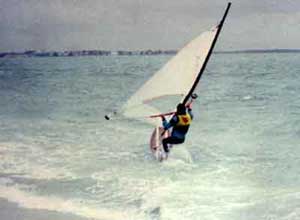
At that time, Dominique surfs mainly on the spot of La Torche, well-known to have received several Funboard World Cups since.
At the same time, Dominique and Bruno were each preparing their own boat to realize a shared personal dream : sailing around the world.
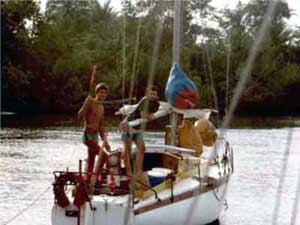
During summer 1983, after one year cruising different waters, Dominique and Bruno meet in Senegal. Life is beautiful, they spend hours discussing high tech sails and other speed devices, their other big passions.
In the beginning they intended to make thick sails for a future boat, then they came to kites as a natural extension of more traditional sail forms.
Another rigging option inspires them, somewhere between a windsurf sail and a kite: the BirdSail.
This system was patented and made by Roland Le Bail (another Breton) in 1982, its principle was to lift the pilot off the water with the aim of realizing higher and longer jumps than with a standard windsurfing board.
But a major defect in the system lay in the impossibility of using big wings.
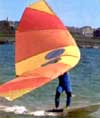
Out of all this jumble of ideas their ultimate project was somehow logically born and which would one day revolutionise the world of water sports: A board, a kite-wing.
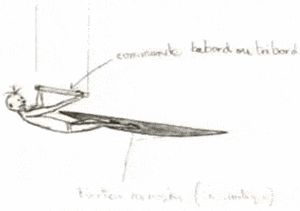
Neither of them having flown kites before, Dominique and Bruno begin by making models to understand the theory of kite flight characteristics, notably how it could be possible to go upwind.
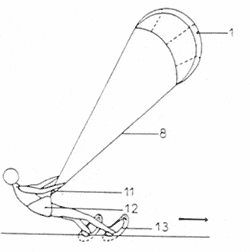
The advantages of kites as sails appear very early on, after which their project becomes the development of a kite wing adapted for nautical use.
The birth of a sea wing

Their first model is a stack of 7 then 12 kites of 0,5 m2, stiffened by fiberglass battens.
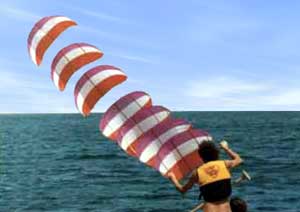
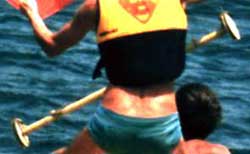
After several months of work, they realise that a wing alone would be more efficient than a stack and that an inflatable frame would outperform battens.
To build bigger kites, they need to return to Brittany, so abandoning their world tour... which they do!
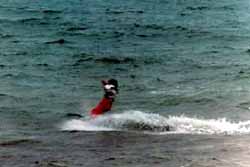
They build their first inflatable kite in october 1984.
They do their first attempts with boards, but their kites are difficult to relaunch, so they find water-skis easier. The power of wings was so great that they had to make very small skis for maximum freedom.
Convinced of having in hand a concept with strong potential, the Legaignoux brothers apply for their first patent on the wing with inflatable structure on November 16, 1984.
A long period of R&D starts to improve the concept, with for top priority: to go up-wind, to go fast and relaunch from water.
During this period they will manufacture many prototypes from 5 to 17 m2, with different L/D ratios and airfoils.
They participate in their first Speed Week, in Brest (Brittany – France), in April 1985 and win the Ingenuity prize. They participate in two other Speed Weeks in 1986.
Their purpose is to convince a board manufacturer to launch the new sport. Unfortunately, it is far too early. The windsurfing market is reaching its peak and everybody considers this sport as the ultimate.
At this time their wings are still at prototype stage and can’t yet go upwind, with board or skis, and they spend more years at the drawing board working on wings, boards and other equipment.
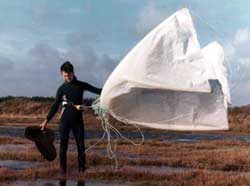
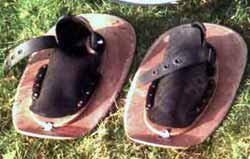
During these years, they test many other possible uses of their kites, trying to find more receptive markets.
In 1985 and 86 they build their most efficient wings, on the principle of very wide spans and 100 % double skin / ram air.
But they are heavy, especially when wet, and rather unstable, requiring permanent steering control which is clearly impossible after falling in the water.
Dominique and Bruno feel that the sport could grow much faster if the wing was more stable.
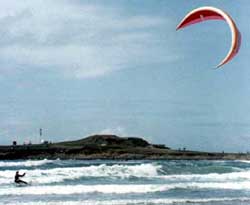
When this photo was taken, the wind was too light for the funboarders to sail. They're the ones watching on the beach.
It was possible to ski in as little as 5-6 knots of wind, but the limiting factor was the ability of the wing to re-launch in such light winds.
Finally after a long period of research and almost one hundred prototypes, it is into 1988-89 that comes a really stable wing, but also lighter (single surface) and easier to relaunch and control.
The wing is almost ready for mass production, but the capacity of their boards and skis to go upwind is still not sufficiently good to launch the sport.
Eventually, they make a good dozen different water devices (boards etc.) able to go upwind, but they consider them too big, too heavy and too expensive. Their leitmotiv: less than 2 metres long and 10 kg weight.
